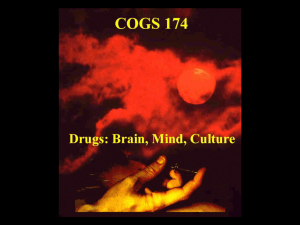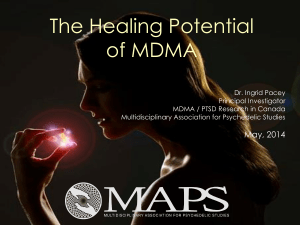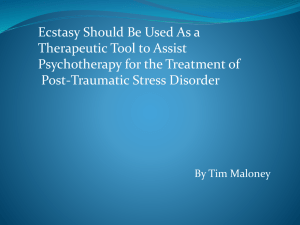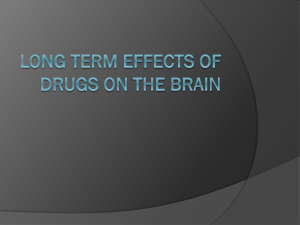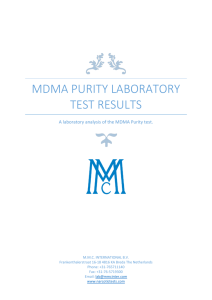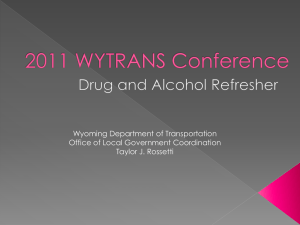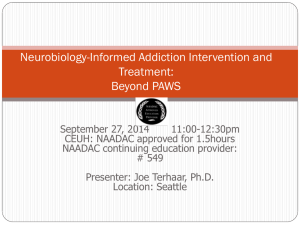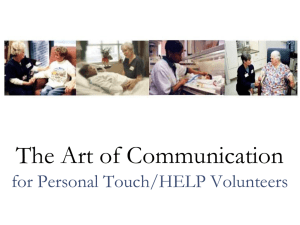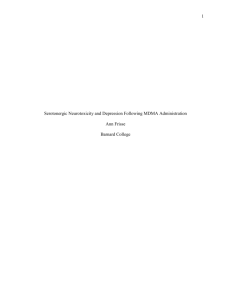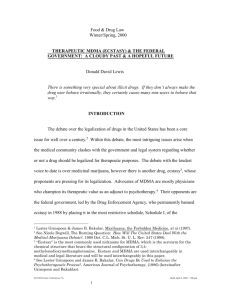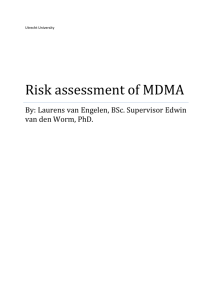mdmA - Department of Cognitive Science
advertisement
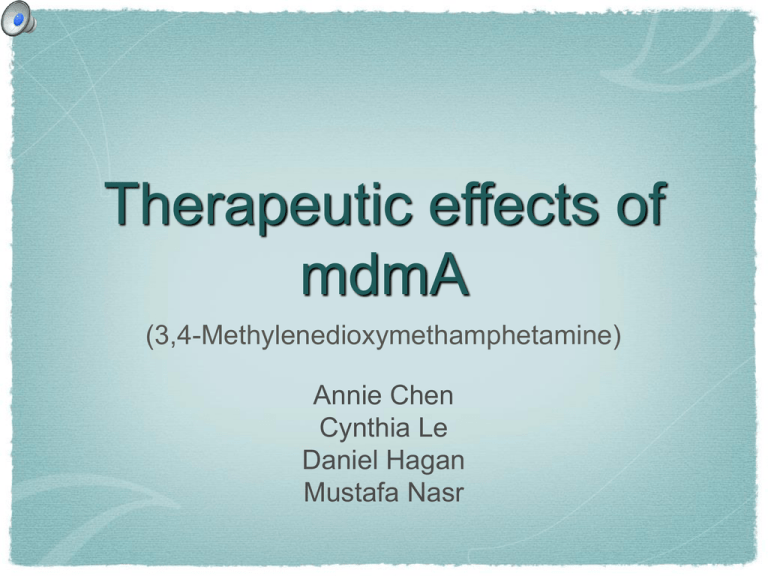
Therapeutic effects of mdmA (3,4-Methylenedioxymethamphetamine) Annie Chen Cynthia Le Daniel Hagan Mustafa Nasr Table of Contents Mechanism of Action Therapeutic Neurobiological Mechanism Neurotoxicity Long term Serotonergic Changes Structural Changes in Serotonergic Axons Role of Oxidative Stress in Neurotoxicity Safety Assessment in Clinical Studies Therapeutic Potential Therapeutic Benefits Therapeutic Dangers Mechanism of Action Primarily serotonergic, but also effects norepinephrine and dopamine Enters pre-synaptic cell via monoamine transporters Inhibits vesicular monoamine transporter Releases monoamines by reversal of respective transporters through phosphorylation Also acts as a weak 5-HT, and 5-HT2 agonist Causes indirect oxytocin secretion by stimulating serotonin system Inhibits rate-limiting enzyme for 5-HT synthesis; typtophan hydroxylase MDMA (Ecstasy) MDMA in synaptic cleft Therapeutic Neurobiological Mechanism Increased oxytocin levels strengthen alliance between patients and therapist Decrease in amygdala activity with an increase in ventromedial prefrontal activity improves emotional regulation and decreases fear and avoidance Increase in norepinephrine and cortisol levels facilitates emotional engagement and extinction of learned fear associations Neurotoxicity Appears to have same risk for neurotoxicity as other psycho-stimulants (i.e. methamphetamine) Very modest risk of acute toxicity in controlled environment Studies with animals have shown that MDMA can decrease brain-functions that rely on serotonin on a long-term basis ( >7 days) However, it is unclear what effect this has on the animals No studies have investigated whether MDMA causes neurotoxicity that only becomes apparent with aging Longterm Serotonergic Changes Decreased brain concentrations of serotonin and its metabolite 5-HIAA Decrease in density of SERT (serotonin re-uptake transporter) Is this down-regulation? Or have serotonergic axons been permanently lost or damaged? Down regulation suggests an active adaptation to the increase in serotonin from ecstasy (MDMA) while axonal loss suggests true damage Structural Changes to Serotonergic Axons Looking at the structure of serotonergic axons in animals exposed to MDMA clearly indicates axonal loss Slices of MDMA exposed animal brain tissue in which 5-HT has been stained show irregular swelling and fragmentation of fine serotonergic axons Swelling suggest damage of axons and this can be proven by measuring the movement of compounds between brain regions connected by serotonergic axons Role of Oxidative Stress in Neurotoxicity Highly reactive chemicals call free radicals damage neural molecules through reduction and oxidation. These reactions alter the ability of neural cells to carry out their normal functions MDMA has been shown to increase oxidative stress in the brain by two separate methods Antioxidants are molecules that react with freeradicals to create harmless molecules Role of Oxidative Stress in Neurotoxicity cont... Mice given extreme doses of antioxidants (or genetically altered to have naturally elevated levels of antioxidants) such as vitamin C and alpha-lipoic acid show no signs of neurotoxicity when given a normally neurotoxic regiment of MDMA (the dose of MDMA and vitamin C are very high) Sustained effects of MDMA may deplete neuronal energy sources and their ability to deal with oxidative stress Both MDMA and Dopamine can be metabolized into highly reactive molecules Safety Assessment in Clinical Studies Range of psychoactive, but non-neurotoxic MDMA closes appears small in most animals However, the dosage and frequency of administration can be kept to the minimum required Furthermore, methods for reducing or blocking neurotoxicity in animals can be employed and likely reduce neurotoxicity at least to some degree in humans Safety Assessment in Clinical Studies cont... Methamphetamine has shown to exhibit at least the same neurotoxicity as MDMA, but the FDA still approves of methamphetamine SSRI’s block SERT and inhibits the function of MDMA When given 3-4 hours after a neurotoxic regiment of MDMA, several SSRI’s (such as paroxotine, fluoxetine and citalopram) can block neurotoxicity in rodents. Although human-trials have not been conducted it is likely that they have a similar effect in humans. Therapeutic Potential Physical and Psychological distress of terminal cancer patients Treatment of PTSD (post-traumatic stress disorder) caused by: Sexual assault War Violent crimes Therapeuti c Benefits Helps break down boundaries in communication Especially useful for patients who are aggressive, defensive and unwilling to “open up” Increased feelings of empathy Increased feelings of acceptance Depersonalization; loosening of ego and boundaries Therapeutic Dangers Chance of psychological dependence Possible adverse effects ‣increased body temp ‣increased heart rate and blood pressure ‣muscle tension ‣jaw clenching nausea Impairment of episodic and working memories and attention History of Therapeutic Use of MDMA Greer & Tolbert ‣MDMA assisted ‣psychotherapy sessions from ‣1980 to 1985 ‣80 patients total ‣screening criteria and informed consent ‣mental set and psychological preparation emphasized Role of Mental Set Set includes expectations, motivations and intentions of individual in regard to the session Mental set both patient and therapist important Goal of developing more compassionate attitude was easily achieved by MDMAassisted therapy Relief from chronic symptoms and behavior problems greater when such change in attitude occurred Approached sessions more as sacred rites of passage than conventional therapy sessions Results & Conclusions MDMA seems to decrease fear response to perceived threat to patient’s emotional integrity Leads to corrective emotional experience Diminishes pathological effects of previous traumatic experiences Acquisition of effective skills for communicating feelings to family members Psychological benefits were lasting up to a 2-year follow-up for most patients Therapeutic Use of MDMA Today Currently only one FDA & DEA approved medical study on MDMA (Schedule 1 drug) MAPS (multidisciplinary association of psychedelic studies) is studying whether MDMA-assisted psychotherapy has potential to heal traumas caused by sexual assault, war, violent crime and other causes In the middle of a 10 year, $10 million plan to make MDMA a government-approved prescription medication MDMA-PTSD U.S. Pilot Study 1st ever protocol evaluating MDMA’s therapeutic applications in clinical trials Randomized, double blind and placebo controlled 21 subjects with treatment resistant PTSD MDMA-assisted psychotherapy produced statistically significant improvements in PTSD symptoms Difference between 2 groups was immediate and maintained throughout the time period Sources http://www.maps.org/research/mdma/ http://www.macalester.edu/psychology/whathap/ubnrp/mdma/therapeutic.html http://www.lycaeum.org/research/researchpdfs/1998_greer_1.pdf Peroutka, Stephen J. Ecstasy: the Clinical, Pharmacological, and Neurotoxicological Effects of the Drug MDMA. Boston: Kluwer Academic, 1990. http://www.science.smith.edu/departments/Biochem/Chm_357/Articles/ecstasy%20toxi city.pdf http://www.erowid.org/library/books/ecstasy_complete.shtml http://www.idmu.co.uk/ecstasy-information/ http://www.springerlink.com/content/9rvc16g5hgmdg6wb/
